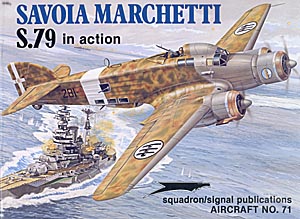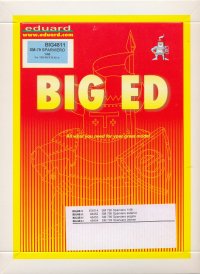|
Trumpeter 1/48 Savoia-Marchetti SM.79 II Sparviero (Sparrowhawk) - Aerosiluranti by Krzysztof Koza |

|
|
|

Click the STORMO! Eagle to return to the Gallery |
|
As the British Spitfire and the American Mustang characterized an era in the history of aviation in their
countries, so too did the 'Sparviero' (Sparrowhawk) for Italy. It was certainly the best known Italian
aeroplane of the Second World War, and saw duty on all fronts. The aircraft was designed as a bomber, but
it became famous as a torpedo-carrier, and was an outstanding airplane. The SM.79 is considered
by many as the best land-based torpedo-bomber of World War II. Between October 1936 and June 1943, a total of 1,217 aeroplanes came off the assembly lines. It was designed by Alessandro Marchetti, and was developed from the earlier SM.81. Like its predecessor, the SM.79 was a low-wing. monoplane, with a wood and metal structure and a composite covering, but the new three-engine aeroplane incorporated many improvements, such as more powerful engines, which improved performance. It had finer aerodynamic lines, and the retractable under-carriage was designed to raise up into the engine nacelle. The prototype had been designed as a civil transport aeroplane with eight seats. The first flight took place in October 1934, when the aeroplane took off from the Cameri Airport in the province of Novara. It was a brilliant debut. Its general performance was outstanding. The aeroplane flew over 220 mph (354 km/h) at sea level and more than 250 mph (402 km/h) at higher altitudes. The aeroplane improved in performance the following year, when 750 hp Alfa Romeo engines were installed in place of the original 610 hp Piaggio P.IX. In the month of September six world speed records were broken, over distances of 625 and 1,250 miles (1,000 and 2,000 km) with loads of 1,100, 2,200, and 4,400 pounds (498, 997 and 1,995 kg). The military authorities were so impressed with this achievement that they ordered a second prototype in a bomber model. This version did not differ structurally from the civil version, and the only changes were alterations to accommodate bombs and armament in the belly, and the raising of the cockpit. The airplane was used in the Spanish Civil War from February 1937, but it also continued to be used as a civil transport and racing aeroplane. A special model with 1,000 hp Piaggio P.XI engines continued to establish speed records. On December 4, 1938, it flew at an average of about 300 mph (482 km/h) over a distance of 621 miles (1,000 km) with a 2 ton (2.02 tonnes) load. One of the aircraft's finest achievements took place on August 20-21, 1937, when five SM.79C racers took the first five places in the Istres-Damascus-Paris race. A distance of almost 4,000 miles (6,437 km) was covered at an average speed of more than 220 mph (354 km). A top speed was established on the Istres-Damascus leg of the flight, when one of the aeroplanes reached 265 mph (426 km/h). In January 1938 three other SM.79s, trans-atlantic models flew from Guidonia, Italy, to Rio de Janeiro, via Dakar - a distance of more than 6,000 miles (9,656 km) at an average speed of more than 250 mph (402 km/h). At the same time a commercial export model was developed, the SM.79B. This was a twin-engine aeroplane with a modified forward section, powered by a pair of 1,030 hp Fiat A.80 RC 41s, or by two 1,000 hp Gnome-Rhone K.14s. A third engine variant was powered by two 1,220 hp Junkers Jumo 211 D in-line engines. A total of 113 of this variant model were produced, 16 of them in Romania on licence. The aeroplane was sold to Iraq, Yugoslavia, Brazil, and Romania. A final version, the SM.79-III, appeared in 1943. When Italy entered the war, there were 594 SM.79s in service. The plane started out as a bomber, but soon was assigned to torpedo carrying, and was outstanding in this role. It continued in this sort of operation after 1943 in the air force of the Aeronautica Nazionale Reppublicana. In the south, the Allies reassigned the aircraft to transport duty. The SM.79s that survived the war were used for some years as transport aeroplanes and target tugs. The last aircraft were retired from service in 1952. Source [1] Angelucci E. and P. Matricardi, "World Aircraft, World War II – Part I", Sampson Low Guides, 1978
|
|
|

As a break and to de-stress between building a PZL P.24B (1:72) and LWS-6 ‘Żubr’ (1:48), and renovations at home, I started a project almost out of the box - a 1/48 S.M.79-II "Sparviero" from Trumpeter
Trumpeter 1/48 SM.79-II Sparviero - TSM2817
with a few extras added below: -YAHU MODELS - YMA4840 Instrument panel
Yahu Models 1/48 SM.79 - YAHA4840
 -MONTEX - Maxi mask MM 48026 -PART S48-121 exterior
Eduard 1/48 SM.79 II Exterior Trumpeter - ED48452
 -EDUARD Seatbelts Italy
Eduard 1/48 Seat Belt Detail Set - ED49017

A well-known model that has been on the market for years. By the way, it will be a treat to paint Italian camouflage while waiting for the call from my local hobby shop that my S.M.79 ‘Sparviero’ model from EDUARD in 1:48
Eduard 1/48 SM.79 Sparviero - EU11179
is now available for pick-up. I started the build with the interior where I added the instrument panel from YAHU and the belts from EDUARD.
Not everything will be visible but the undercarriage shin together with an improved tailwheel. In the photo you can see the new shin and what was in the kit but still almost all of it will not be visible.


The next sheet metal window frames are fitted and I can close the fuselage. The fuselage windows are then masked off.
The model is put together but the fun with the tinsel goes all the way. On the 1 ‘euro cent’ coin are the tension parts on the rear tailplane.
The new headlight is also made even the bulb I fitted. I shaped the reflector mirror using a ball from a bearing. I had the most fun with the torpedoes and their handles, but the result was worth the work.
The beginning of playing with the rest of the camouflage, this is the moment I always enjoy. Painting freehand without masking or stencils. By the way you can see my mess on my makeshift workstation.
I painted the camouflage spots alternating a few ‘green’ and then a few ‘brown’ and so on until I managed to paint the whole thing. The control surfaces were temporarily fixed with tape for the painting time.



The camouflage is finished, now the masks for painting the markings and finally some decals. Putting the model together, doing the stretches and the model is ready. I know there are some inaccuracies but I wanted to do it straight from the box. All in all, the build went smoothly, the parts fit together, it was a pleasure. Now I have one more ‘Sparviero’ model waiting for me, but this one will be from the EDUARD kit.
Eduard 1/48 SM.79 Sparviero - EU11179
To paint it, I used paints dedicated to Italian aviation from the MR paint company.
And so another completed model landed in the display case, and it is the S.M. 79-II ‘Sparviero’ described above, 283 squadriglia, 130 gruppo autonoma, Mediterranean 1942.
|
Aircraft: SIAI-Marchetti SM.79 Manufacturer: SIAI-Marchetti Type: Bomber Year: 1937 Engine: Three Alfa Romeo A.R. 126 RC 34, 9-cylinder radial, air-cooled, 750 hp each Wingspan: 69 ft 7 in (21.20 m) Length: 53 ft 2 in (16.20 m) Height: 13 ft 5t in (4.10 m) Weight: 23,180 lb (10,500 kg) (Loaded) Maximum Speed: 267 mph (430 km/h) at 13,120 ft (4,000 m) Ceiling: 23,000 ft (7,000 m) Range: 1,180 miles (1,900 km) Armament: 4-5 machine guns; 1 x 1,931 lb (876 kg) torpedo Crew: 6 |








|
|
|

|
|
|


|


|







|










|
|
|
|
August, 2024 STORMO! © 2024 |